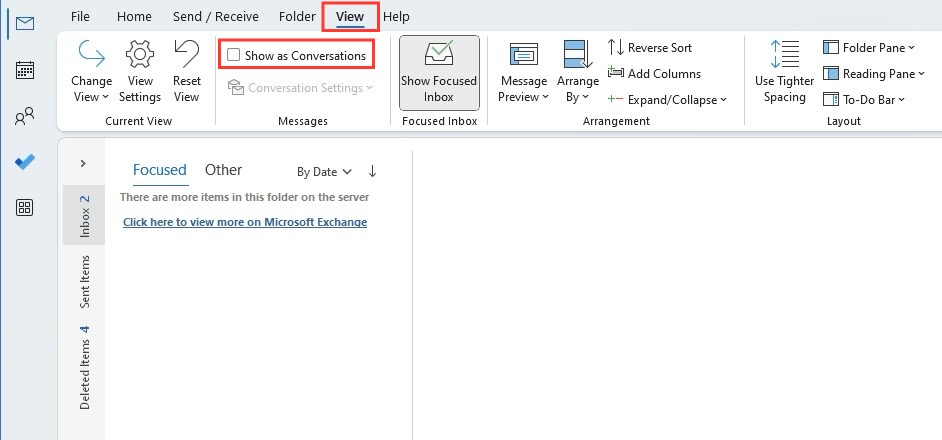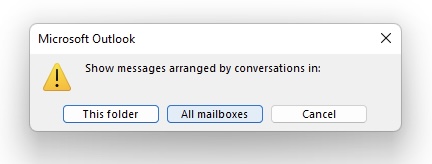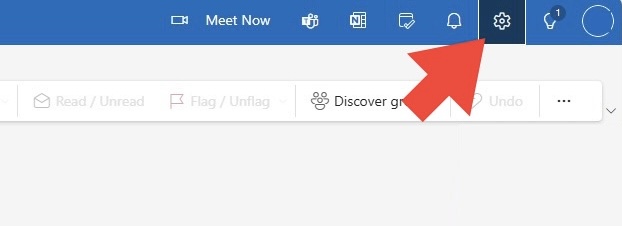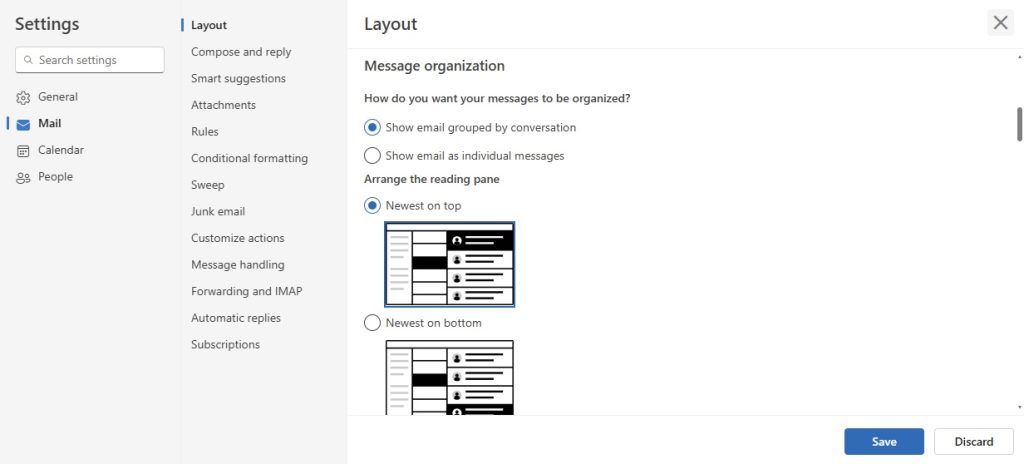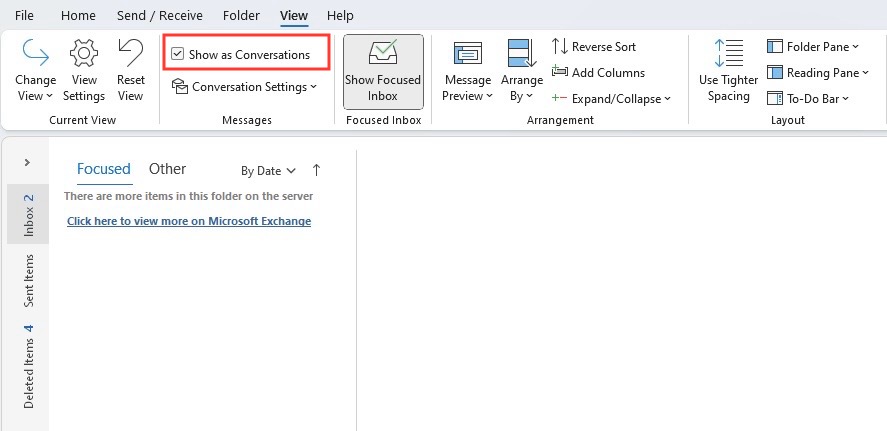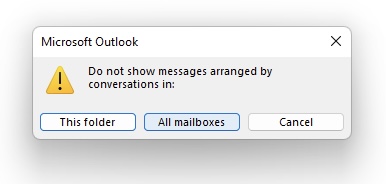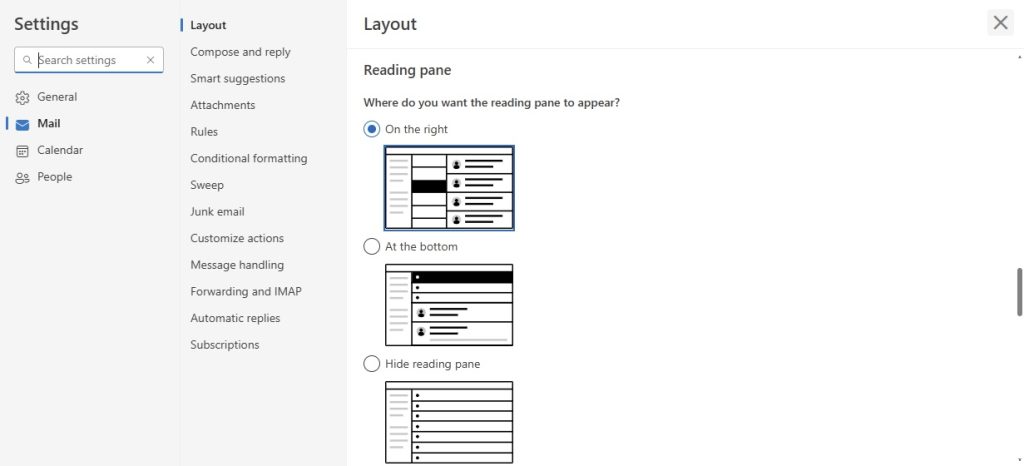Staying on top of my inbox can sometimes feel like navigating through a maze. That’s where tools like the Outlook Conversation View help. They simplify my email management by grouping related messages together, making it easier to track ongoing discussions. This feature is especially useful when I’m juggling multiple threads with the same participants.
I don’t have to scroll through a sea of emails to find the ones linked to a specific topic. Conversation View shows me an organized cluster of emails, minimizing the clutter and making my inbox more manageable.
Key Takeaways
- To toggle Conversation View on or off in Outlook, access the View tab and check or uncheck the “Show as Conversations” option, then apply it to your desired folder or all mailboxes.
- For Outlook Web Access (OWA), use the Gear icon to open Settings, navigate to Mail > Layout > Message Organization, and switch Conversation View settings accordingly.
- If Conversation View does not meet your needs, Outlook easily allows you to disable this feature, ensuring that emails are not grouped as threads but listed individually.
Outlook’s Features That Enhance User Email Management
Outlook doesn’t just stop at Conversation View when it comes to keeping your emails in check – they’ve built a whole arsenal of features to help streamline your email management. You can sort your messages using categories, flag emails for follow-ups, and even set up automatic rules to direct incoming mail to specific folders. Plus, their search functionality is quite robust, allowing you to locate emails quickly using keywords, sender names, or dates.
Features such as the Focused Inbox separate your high-priority messages, so they stand out from the rest, ensuring that important communications don’t get lost in the noise. And if that wasn’t enough, you also have the Sweep feature, which can declutter your inbox by automatically moving or deleting old emails based on your preferences.
By combining these tools, you can tailor your Outlook experience to fit your workflow, ultimately boosting your productivity.
Table of Contents
Understanding Outlook Conversation View
What is Conversation View?
Conversation View is a neat feature in Outlook that groups all emails from the same conversation thread together, displaying them as a single, collapsible entry in your inbox. This means that when you receive a reply to an email, it doesn’t just pop up as a new message but instead gets neatly tucked under the original email. This view ensures that you see the entire conversation in sequential order, allowing for easy tracking of the discussion’s progress and context.
By bundling related emails, Conversation View keeps you from sifting through individual messages related to the same topic. It’s much like following a storyline – each email is akin to a chapter, and Conversation View keeps all the chapters in the right order, so you don’t miss a beat of the narrative.
How to Enable Conversation View in Outlook Classic
STEP 1: Open Outlook and log into your account.
STEP 2: Click on the View tab.
STEP 3: Check the Show as Conversations box.
STEP 4: Click on either This folder or All Mailboxes.
Now, your emails will be grouped by conversations, making it easier to track ongoing discussions.
How to Enable Conversation View in Outlook Web Version
STEP 1: Open Outlook and log into your account.
STEP 2: Click on the Settings icon.
STEP 3: Click on Mail > Layout > Show email grouped by conversation.
STEP 4: Click on Save.
Now, your emails will be grouped by conversations, making it easier to track ongoing discussions.
How Does Conversation View Organize Your Messages?
Conversation View organizes your messages by clustering them around the common subject line. It’s pretty smart – it doesn’t just look for identical subject lines; it also recognizes threads, so even if someone tweaks the subject slightly in a reply, it still knows to keep that email in the same group. When you expand that conversation, you’ll see every related message, whether sent or received, grouped in the order they were received.
What’s even cooler is that Conversation View spans across all your folders, not just your inbox. So, if you’ve moved some messages to specific folders, but they’re part of an ongoing thread, those emails will still appear in the conversation in your inbox or the specific folder where the thread resides.
This avoids duplication and makes sure you have a complete, uninterrupted view of the dialogue as it unfolds, which can be really handy when you’re trying to remember what was said or need information sent earlier in the conversation without shuffling through various places.
Advantages of Using Conversation View in Outlook
Improved Clarity and Email Navigation
The clarity that Conversation View brings to my inbox is like finally cleaning my glasses after a long day. With everything neatly grouped, I’m less likely to overlook important messages or get sidetracked by unrelated ones. I navigate through entire conversations with ease, and it’s simple to reply to or forward the entire thread when needed.
This efficiency boost is a nod to Outlook’s commitment to accessibility – simplifying navigation makes email less of a chore and more of a streamlined tool for communication. Identifying the most recent messages is a breeze since they’re often displayed at the top or bottom of the conversation stack, depending on my settings.
Whether I’m coordinating with colleagues on a project, planning an event, or managing customer queries, this clear, organized view minimizes mistakes and maximizes my ability to respond effectively.
Disabling Conversation View for a Traditional Inbox
Reasons to Disable Conversation View
While Conversation View has its fans, it might not be everyone’s cup of tea. Some prefer a more traditional view where each message stands alone, feeling that it offers a clearer snapshot of their incoming and outgoing mail. This might be the case especially for those who thrive on a linear, message-by-message approach to email processing, or simply find the threaded view too cluttered.
Another reason you might want to disable Conversation View is if you occasionally miss emails because they’re nestled within a thread. It’s tempting to skip over a conversation thinking you’ve read all the messages when, in fact, a new one has snuck in. Additionally, if search habits are geared towards individual messages rather than whole conversations, this feature can seem more like a hindrance than a help.
Overall, going back to a traditional inbox layout can make you feel like you’re back in control, especially if that’s what you’ve been used to for years. It’s all about what works best for your unique email management style.
Step-by-Step Guide to Turning Off Conversation View
Turning off Conversation View and reclaiming the classic inbox look can be done in just a few easy steps:
STEP 1: First things first, you’ll want to log into your Outlook mail. Once in, click on the Settings icon – it looks like a cogwheel – tucked away in the top-right corner of the screen.
STEP 2: From there, navigate to the View tab. It’s often right at the top of the menu.
STEP 3: Search for the Show as Conversations option and give it an uncheck. This action will signal that you’re after the traditional look rather than the conversational bundling.
STEP 4: Now, Outlook will prompt you to confirm where you want this change to apply. You’ve got two choices: either select This folder to apply the change solely to the folder you’re currently in or opt for All mailboxes if you’re ready to nix the conversation view across the board.
And voilà – the Conversation View feature is turned off! Your emails will now appear as individual messages. If ever you decide to give Conversation View another whirl, you can simply revert these steps to turn it back on.
Personalizing Your Outlook Experience
Customizing Message Display Preferences
Did you know that Outlook lets you decide how your messages make their first impression? Go ahead and tailor the Message List to your liking – maybe you want the sender’s name to pop out, or perhaps the subject line is more your focal point. To dip your toes into customization, head over to the Outlook’s Settings and find your way to the Layout options.
Under the Message list format, select the option that sings to you – be it putting the sender’s name first or letting the subject line take the lead. Whichever you choose will reshape the way messages line up in your inbox, giving you a little visual nudge so that you can spot your priority emails in a snap.
Remember, your inbox, your rules – tweak until it feels just right.
Adjusting Reading Pane Appearance for Optimal Comfort
Your Reading Pane is essentially your email stage, and optimizing it for your comfort can transform your email experience. To adjust the Reading Pane in Outlook, you just need a few clicks to make it work for you:
STEP 1: In Outlook, head up to the Settings cog again and select Mail followed by the Layout options.
STEP 2: Here’s where you decide on your viewing angle by selecting the Reading Pane options. Do you fancy your reading pane to the right, keeping your inbox in view? Or perhaps you prefer it at the bottom for a more horizontal perspective?
STEP 3: Once you’ve picked your preferred locale, consider whether you want to see the emails as individual messages or grouped by conversation. Your eyes will guide you here!
Whatever your choice, the idea is to create a visual workflow that keeps eye strain at bay and makes managing your emails as cozy as pulling up your favorite chair.
Navigating the Changes in Outlook Versions
Differences Between Outlook on the Web/Outlook.com and Outlook Software
Navigating the nuances between Outlook on the Web (formerly known as Outlook Web App) and the Outlook desktop software can sometimes feel like you’re comparing two sides of the same coin. While they share the core functionality of email management, there are distinct differences in their feature sets and user interfaces.
Outlook on the Web, accessible through your browser, is all about accessibility and quickness. It’s perfect for those on-the-go moments when you need to check your email from any device with internet access. You’ll find that it has a more streamlined interface with fewer bells and whistles, but that’s by design to ensure speed and ease of use.
The Outlook desktop software, on the other hand, is a beefier application installed on your computer. It offers a broader range of options, like advanced mail sorting and more in-depth customization settings. It’s ideal for the power user who needs those extra tools and prefers a more hands-on approach to their email management.
When deciding whether the simplicity of Outlook on the Web or the feature-rich Outlook desktop software is right for you, consider your workflow, accessibility needs, and the complexity of your email tasks.
Finding Help and Additional Resources for Outlook Settings
Need a hand tweaking Outlook settings or finding your way around a new feature? There’s plenty of support available. Start with Outlook’s own Help feature, which you can summon with a simple F1 press or by selecting the question mark icon within the application. This nifty tool can guide you through everything from setting up your account to troubleshooting common issues.
If the built-in help doesn’t cut it, the online community and official Office support website are treasure troves of tutorials and forums where you can pick the brains of fellow users and Microsoft experts. For more visual learners, you might find a wealth of instructional videos on Microsoft’s YouTube channel or various tech education platforms.
And let’s not forget about professional training courses – both online and in-person – that can take your Outlook skills from newbie to ninja in no time.
Commonly Encountered Issues with Outlook Conversation View
Dealing with Overlapping Conversations
When conversations overlap, things can get a bit tangled. This happens when multiple threads have the same or very similar subjects, which might cause Outlook to bunch them together. To untwist these overlaps, you might need to do a bit of manual sorting. Start by carefully reading the subject lines and the participants in each conversation. You can correct any misgrouped messages by dragging them to the right thread or creating a new one.
Another pro tip is to slightly alter the subject lines for clarity. This encourages Outlook’s Conversation View to differentiate between threads, reducing the likelihood of messages getting crossed. And, of enhancements, don’t forget to leverage Outlook’s Clean Up feature, which helps you remove redundant messages within a conversation to tidy up effectively.
If the issue persists, consider reaching out to your correspondents and kindly request more distinctive subject lines to prevent future overlaps.
Handling Misplaced or Missing Emails
Stumbling across misplaced or missing emails in Outlook can be a bit like solving a mystery. But before you call in the detectives, there are some quick fixes to try:
- Double-check that Conversation View is configured correctly. Sometimes, emails can hide within a conversation thread, especially if they’re part of a lengthy back-and-forth.
- Make use of the Search function. Sometimes emails haven’t gone missing; they’re just in a different folder than you remember. A thorough search can often bring them back into the light.
- Peek into your Junk Email or Deleted Items folders. An overzealous spam filter might have intercepted an important email, so it’s always worth checking these folders just in case.
If the emails remain elusive, consider retracing your steps with Outlook’s Recovery feature for recently deleted emails. And for ongoing issues, creating specific rules to direct incoming mail can save future headaches.
Just remember, a little bit of Inbox housekeeping goes a long way to prevent emails from disappearing without a trace.
Tips for Effective Email Management Beyond Conversation View
Utilizing Focused Inbox to Sort Priority Emails
Think of Focused Inbox as your personal email sorter, slicing through the daily email pile to spotlight what demands your immediate attention. Activating this feature is a breeze. Pop into Outlook’s Settings, and under Mail > Layout, you’ll find the Focused Inbox option. Flip the switch, and just like that, Outlook will start sorting your messages into two tabs: Focused and Other.
Emails deemed important land in the Focused tab, while the rest wait quietly under Other. This sorting is based on the email content, your contact interactions, and past email behavior – pretty clever, right?
Utilizing Focused Inbox helps you earmark high-priority emails, ensuring they never get lost in the shuffle of newsletters, social updates, and those pesky promotional offers. And don’t worry, Outlook learns as you go, so if it doesn’t get the sorting right initially, you can train it by moving emails between tabs, and it will remember your preferences for next time.
Adding or Removing Columns for Better Visibility in List View
If you fancy a bird’s-eye view of your email landscape, customizing columns in List View helps you see just the information that matters to you. Want the sender’s name to take center stage? Or perhaps the email size is critical for your workflow? Adding or removing columns can be done in a few steps:
First, make sure you’re in List View by selecting Change View under the View menu. Then, dive into View Settings and click on Columns. From there, you can pick and choose the columns that are relevant to you and even create custom columns featuring specific types of information.
To add, pluck your preferred column from the Available columns list and tap Add. To remove, select a column name from the Show these columns list and hit Remove. Don’t forget to click OK to save the layout. It’s important to remember that if you don’t see changes, you might need to switch to List View first then, re-arrange your columns.
This setup not only makes your inbox neater but also arms you with the information you need at a glance, making your email management that much more efficient.
FAQ – Frequently Asked Questions
How Can I Enable Conversation View in Outlook?
To enable Conversation View in Outlook and keep related emails bundled together, just head to the View tab at the top of your screen. Check the box next to Show as Conversations, and then choose the folder you wish to apply this change to. That’s all! You’ll notice little arrows next to email threads indicating they’re part of a grouped conversation.
Can I Customize Conversation View Options for Different Folders?
Absolutely, you can tailor Conversation View settings for different folders in Outlook. Simply visit the View tab, click on Conversation Settings, and then apply your preferred options to the selected folder. This lets you keep some folders in a traditional view and others grouped by conversations, offering a personalized email sorting strategy that best suits your needs.
What Should I Do if Conversation View Isn’t Working as Expected?
If Conversation View in Outlook isn’t acting as it should, first double-check that it’s enabled in the View tab. If issues persist, try toggling Conversation View off and on again. Should the problem continue, look into adjusting the settings under Conversation Settings to ensure they’re set up correctly. And, if you’re still stuck, contact Outlook support for a helping hand.
Does Disabling Conversation View Affect How Others Receive My Emails?
Disabling Conversation View in your Outlook doesn’t impact how others receive your emails at all. It’s purely a personal preference setting that tweaks how you view messages in your own inbox. Everyone else will see your emails based on their own settings, so you can adjust yours without a hint of worry about creating waves in someone else’s email flow.
John Michaloudis is a former accountant and finance analyst at General Electric, a Microsoft MVP since 2020, an Amazon #1 bestselling author of 4 Microsoft Excel books and teacher of Microsoft Excel & Office over at his flagship MyExcelOnline Academy Online Course.

